|
Is Brussels a City of Foreigners? (No.20)
11th of June 2013
You would be surprised if I told you that 75% of the residents in Brussels are foreigners, but this is a fact according to an article in a local newspaper the other day. At present, there are 1.1 million inhabitants in the international city of Brussels-Capital Region. Among these, the number of foreigners in the broadest sense, including immigrants with Belgian nationality and children whose parents are foreigners, amounts to 840.000 people. Furthermore, of the 19 communes that make up Brussels-Capital Region, the percentage of foreigners in the 4 communes that are concentrated in the city centre is more than 90%. Even in the commune in the southeast of the city with the lowest percentage of foreigners, the ratio is 36%. Looking at the different nationalities of these foreigners, Moroccans represent the largest group (191.300 people), followed by the French (98.300 people), the Italians (75.300) and the Turks (53.800 people). In addition, the percentage of Muslims per commune was also described in the local newspaper. According to it, the Muslim ratio in Brussels-Capital Region is 23% on average, but in the commune of Saint-Josse, close to the city centre, 47% of the population is Muslim (more than half of them are Turkish), which is an astounding figure. The percentage of foreigners in the commune of Ixelles in the south of Brussels-Capital Region, where the residence of the Japanese Ambassador is located, amounts to more than 90%, but the Muslim ratio is considerably low (15%). On the other hand, of the 19 communes, the percentage of French is the highest (20%) in Ixelles. The Muslim ratio in the commune of Uccle in the south of Brussels- Capital Region is 6% and that of the French 18%. It proves that the rumour that “the French are moving to the south of Brussels” is close to the truth. The presence of diplomatic missions, of which is said that there are 300 ambassadors in Brussels, seems not the main reason for the many foreigners in Brussels.
< The Veteran Mayor of the Commune of Ixelles >
At the end of last month, I paid a belated courtesy call to Mayor Willy Decourty of the commune of Ixelles, in which the residence of the Japanese Ambassador is located. There are 84.000 inhabitants in Ixelles, which makes it the third most populated commune of the 19 communes that make up Brussels- Capital Region. The interesting thing about this commune is the fact that it has three different faces. In the northern part shopping streets and a folksy residential area are mixed and the southern part is divided into a high-class residential area with also the Japanese Ambassador’s residence and a student town centred on the Free University of Brussels (ULB). As mentioned earlier, many foreigners are living in this commune. Students from Africa and immigrants from the Democratic Republic of Congo, the former Belgian colony, are residing in the north close to the city centre (especially in the Matonge quarter). Diplomats and immigrants from France are living in the south. Because of this situation, the inflow and outflow ratio of residents is 10% every year and the rise in real estate prices as well is significant. According to the mayor of Ixelles, not many serious crimes occur although drug trafficking is taking place in the back alleys in part of the north side. The residents’ tax is 7.5% in Ixelles which is relatively high among the 19 communes in Brussels, but even for the mayor who has been in charge of the city administration for more than 12 years since 2001, making financial ends meet is by no means easy. We talked about famous people that once lived in Ixelles at the end of our informal talk and the mayor mentioned the names of Karl Marx and Lenin. Just as one would expect from a socialist politician…
< Two Universities in Wallonia >
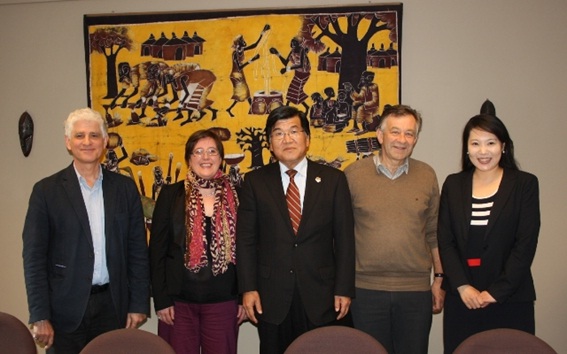 Last month, I visited the University of Namur, located 65 km southeast of Brussels, for a one-hour meeting with the Rector, Mr. Yves Poullet. This university was founded in 1831 as a mission school by the Society of Jesus and even now the educational philosophy of the Jesuits in the field of religious studies and philosophy remains alive. 6218 students, including 597 foreign students, are enrolled in 6 faculties. Most foreign students come from European countries and there is not a single Japanese student. Characteristic of this university is that they are strong in the field of bio and nanotechnology and in IT. 653 researchers from inside and outside the university make up 68 research teams and 632 projects focusing on interdisciplinary research are underway. In the context of strengthening the ties with Asia, I expressed my hope for research collaboration with Japanese companies and for the organization of cultural activities through the Embassy of Japan. Last month, I visited the University of Namur, located 65 km southeast of Brussels, for a one-hour meeting with the Rector, Mr. Yves Poullet. This university was founded in 1831 as a mission school by the Society of Jesus and even now the educational philosophy of the Jesuits in the field of religious studies and philosophy remains alive. 6218 students, including 597 foreign students, are enrolled in 6 faculties. Most foreign students come from European countries and there is not a single Japanese student. Characteristic of this university is that they are strong in the field of bio and nanotechnology and in IT. 653 researchers from inside and outside the university make up 68 research teams and 632 projects focusing on interdisciplinary research are underway. In the context of strengthening the ties with Asia, I expressed my hope for research collaboration with Japanese companies and for the organization of cultural activities through the Embassy of Japan.
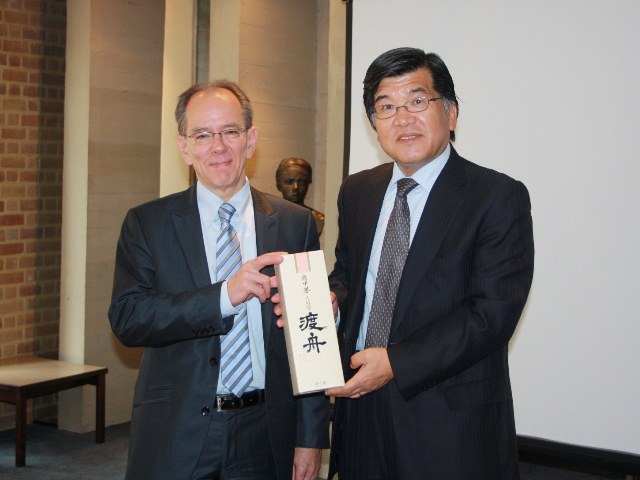 Next, I visited the Catholic University of Louvain where I had a meeting with the Rector, Mr. Bruno Delvaux and had a guided tour on the campus. I mentioned in Ambassador’s Chat No. 3 that the UCL was divided into two universities due to the university conflict in 1966-1967 during which the Dutch education clashed with the French education. The UCL is the French-speaking University that was newly built in Louvain-la-Neuve. In those days, the terrain was a huge hill with only 4 farms, but 40 years later it has developed into a big university with 28.600 students in 14 faculties. The university emphasises in particular scientific research, the industry-university cooperation in research is thriving and I was surprised to hear that among the three science parks, the biggest park boasts 231 ha. Academic exchanges with focus on science are advancing with many universities in Japan. Although there is no Japanese Department in UCL, about 60 students (40 second graders, 20 third graders) are learning Japanese under the guidance of a Japanese teacher. There are about 5000 foreign students enrolled, including 329 Asians. There are about 10 regular students from Japan and even if we add the exchange students there are not more than 20 Japanese. However, every year 30 students from Fukuoka University visit for a three-week summer program to study French. Anyway, the students are really lucky to be able to study diligently in this university with a magnificent campus to be envious of. Next, I visited the Catholic University of Louvain where I had a meeting with the Rector, Mr. Bruno Delvaux and had a guided tour on the campus. I mentioned in Ambassador’s Chat No. 3 that the UCL was divided into two universities due to the university conflict in 1966-1967 during which the Dutch education clashed with the French education. The UCL is the French-speaking University that was newly built in Louvain-la-Neuve. In those days, the terrain was a huge hill with only 4 farms, but 40 years later it has developed into a big university with 28.600 students in 14 faculties. The university emphasises in particular scientific research, the industry-university cooperation in research is thriving and I was surprised to hear that among the three science parks, the biggest park boasts 231 ha. Academic exchanges with focus on science are advancing with many universities in Japan. Although there is no Japanese Department in UCL, about 60 students (40 second graders, 20 third graders) are learning Japanese under the guidance of a Japanese teacher. There are about 5000 foreign students enrolled, including 329 Asians. There are about 10 regular students from Japan and even if we add the exchange students there are not more than 20 Japanese. However, every year 30 students from Fukuoka University visit for a three-week summer program to study French. Anyway, the students are really lucky to be able to study diligently in this university with a magnificent campus to be envious of.
< A Huge Research Organization Called IMEC >
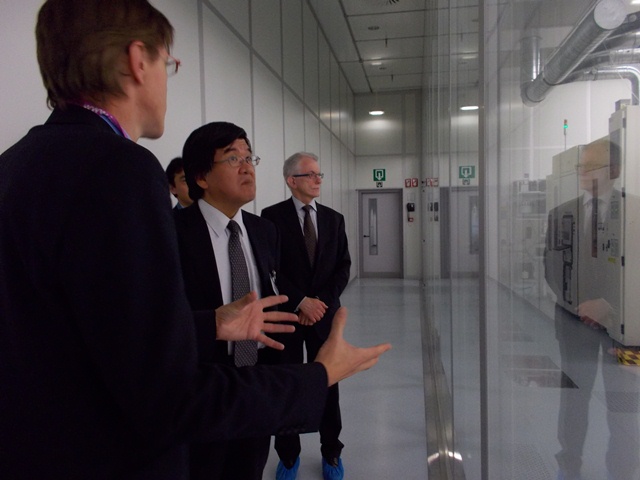 A week ago I visited Leuven, located 30 km east of Brussels, for a visit to IMEC, a huge international research organization. This research organization was established in 1984 as an independent non-profit organization by the Flemish government and at first it was a small organization belonging to the KUL. However, today it has developed into a major international research institute with 2051 researchers. The research area ranges variously from health care to new energy to the field of telecommunications. There are more than 950 foreign researchers from 74 countries and IMEC has signed research collaborations with no less than 600 companies and 200 universities. The total annual revenue (2012) focusing on the costs of research cooperation with private companies amounts to 320 million euro. As for Japanese relations, 64 researchers dispatched from mainly private companies belong to IMEC, which is the fifth largest group among the foreign researchers. There is an IMEC liaison office in Tokyo and every year in November a seminar attended by more than 350 people is held at a hotel in the city. According to Senior Vice President Mr. Roger De Keersmaecker, the biggest attraction of IMEC is that as a member of the international research team one can utilize state-of-the-art research facilities and that contracted companies can save considerably on research and development costs by applying the research results to their own company’s products as well. They also hope to set up a “Japanese IMEC” in the future. It might be a niche business strategy which suits the small country of Belgium. A week ago I visited Leuven, located 30 km east of Brussels, for a visit to IMEC, a huge international research organization. This research organization was established in 1984 as an independent non-profit organization by the Flemish government and at first it was a small organization belonging to the KUL. However, today it has developed into a major international research institute with 2051 researchers. The research area ranges variously from health care to new energy to the field of telecommunications. There are more than 950 foreign researchers from 74 countries and IMEC has signed research collaborations with no less than 600 companies and 200 universities. The total annual revenue (2012) focusing on the costs of research cooperation with private companies amounts to 320 million euro. As for Japanese relations, 64 researchers dispatched from mainly private companies belong to IMEC, which is the fifth largest group among the foreign researchers. There is an IMEC liaison office in Tokyo and every year in November a seminar attended by more than 350 people is held at a hotel in the city. According to Senior Vice President Mr. Roger De Keersmaecker, the biggest attraction of IMEC is that as a member of the international research team one can utilize state-of-the-art research facilities and that contracted companies can save considerably on research and development costs by applying the research results to their own company’s products as well. They also hope to set up a “Japanese IMEC” in the future. It might be a niche business strategy which suits the small country of Belgium.
< The Nihonjinkai of Belgium >
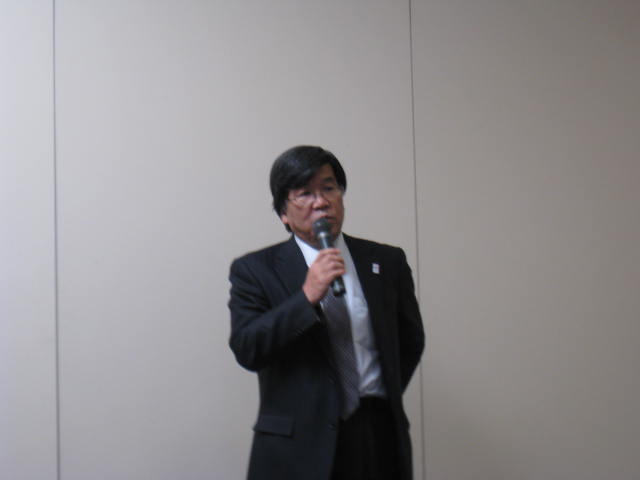 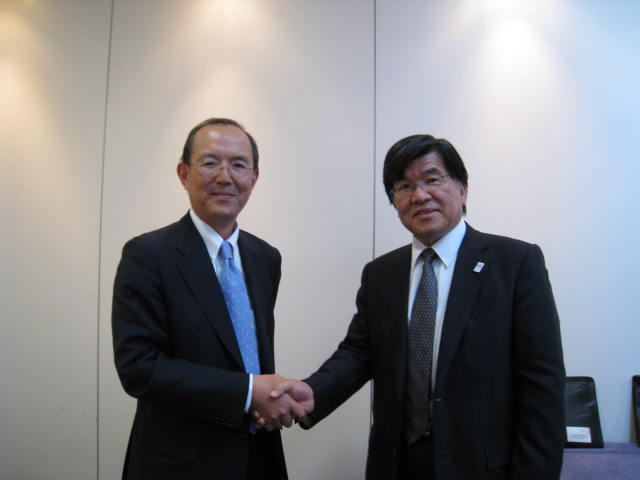 In Belgium, as in other countries, there is an association of Japanese residents called the “Nihonjinkai” (Japanese Association), established 33 years ago. The number of active members amounts currently to 170 companies (in addition to these, there are also 103 individual members), which is a decrease of more than 30% compared to the peak of 1997 (253 companies). The other day, at the General Assembly, I made a salutation speech to all the members as the honorary chairman. In this speech, I stated that, in addition to my New Year’s resolution of quitting the complaining this year, which I announced at the beginning of this year at the New Year’s Reception, it is my goal to “stop comparing with others and pursue the road you believe in”. This is naturally self-reproach. Well, in addition to the Council as the highest decision-making body, committees in charge of commerce and industry, culture and a newsletter have been established. The Committee on Commerce and Industry has created 8 industry-specific subcommittees, which hold from time to time business seminars to support the activities of Japanese companies. They study the latest developments in the Belgian tax system and labour laws and more recently, in view of the early start of negotiations for the Japan-EU Economic Partnership Agreement, they also submitted the demanding paper to both Belgian and European authorities. In terms of culture on the other hand, they hold a tennis and golf tournament to promote friendship among its members and they are also developing club activities such as art and music, typical in Belgium. The management of the Japanese School as well is an important job of the Nihonjinkai. What troubles the Nihonjinkai is the decrease in the membership fees due to the withdrawal of regular members (corporations) and this is a common trend in the Nihonjinkai in all European countries in recent years. In Vietnam, my previous post, the opposite phenomenon occurred: every year the number of member companies increased. Although the member companies remain, many companies are reducing the number of expatriates as well, which means that there are fewer participants to the Nihonjinkai’s events. In Belgium, as in other countries, there is an association of Japanese residents called the “Nihonjinkai” (Japanese Association), established 33 years ago. The number of active members amounts currently to 170 companies (in addition to these, there are also 103 individual members), which is a decrease of more than 30% compared to the peak of 1997 (253 companies). The other day, at the General Assembly, I made a salutation speech to all the members as the honorary chairman. In this speech, I stated that, in addition to my New Year’s resolution of quitting the complaining this year, which I announced at the beginning of this year at the New Year’s Reception, it is my goal to “stop comparing with others and pursue the road you believe in”. This is naturally self-reproach. Well, in addition to the Council as the highest decision-making body, committees in charge of commerce and industry, culture and a newsletter have been established. The Committee on Commerce and Industry has created 8 industry-specific subcommittees, which hold from time to time business seminars to support the activities of Japanese companies. They study the latest developments in the Belgian tax system and labour laws and more recently, in view of the early start of negotiations for the Japan-EU Economic Partnership Agreement, they also submitted the demanding paper to both Belgian and European authorities. In terms of culture on the other hand, they hold a tennis and golf tournament to promote friendship among its members and they are also developing club activities such as art and music, typical in Belgium. The management of the Japanese School as well is an important job of the Nihonjinkai. What troubles the Nihonjinkai is the decrease in the membership fees due to the withdrawal of regular members (corporations) and this is a common trend in the Nihonjinkai in all European countries in recent years. In Vietnam, my previous post, the opposite phenomenon occurred: every year the number of member companies increased. Although the member companies remain, many companies are reducing the number of expatriates as well, which means that there are fewer participants to the Nihonjinkai’s events.
< Ghent’s Marathon Man >
Last week, an interesting marathon event was held in Ghent (60km to the west of Brussels). The organizer was Mr. Stefaan Engels, the world record holder of consecutive marathons in the Guinness Book of Records. He is the “Marathon Man”, who finished 365 consecutive complete marathons three years ago. The previous world record holder was the Japanese Mr. Akinori Kusuda, who completed 52 consecutive marathons and who was also invited to the event in Ghent. The challenge of Mr. Engels now is a new project in which every day a different runner completes a marathon for 365 consecutive days. The start was given on New Year’s Day, so the 160th marathon has been finished already. Last Sunday, the 52-year-old Mr. Engels and the 70-year-old Mr. Kusuda ran together 8 laps around the Watersportbaan, a city course of about 5km per lap. I love to watch marathons, but I don’t like running myself. For that reason alone, anyone who runs a marathon has my respect, but running 365 consecutive marathons is totally unbelievable.
|

